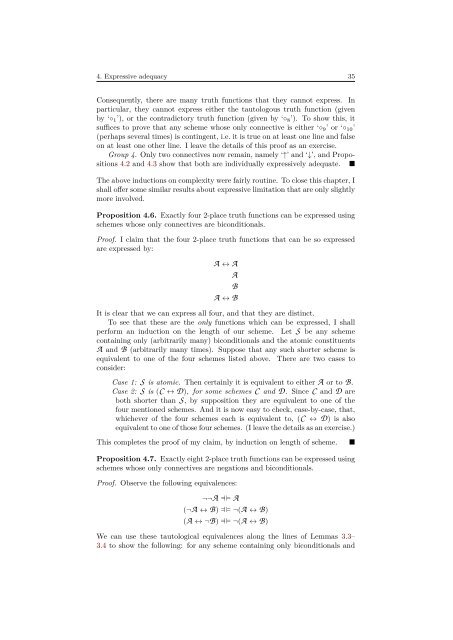Metatheory - University of Cambridge
Metatheory - University of Cambridge
Metatheory - University of Cambridge
Create successful ePaper yourself
Turn your PDF publications into a flip-book with our unique Google optimized e-Paper software.
4. Expressive adequacy 35<br />
Consequently, there are many truth functions that they cannot express. In<br />
particular, they cannot express either the tautologous truth function (given<br />
by ‘◦ 1 ’), or the contradictory truth function (given by ‘◦ 8 ’). To show this, it<br />
suffices to prove that any scheme whose only connective is either ‘◦ 9 ’ or ‘◦ 10 ’<br />
(perhaps several times) is contingent, i.e. it is true on at least one line and false<br />
on at least one other line. I leave the details <strong>of</strong> this pro<strong>of</strong> as an exercise.<br />
Group 4. Only two connectives now remain, namely ‘↑’ and ‘↓’, and Propositions<br />
4.2 and 4.3 show that both are individually expressively adequate. ■<br />
The above inductions on complexity were fairly routine. To close this chapter, I<br />
shall <strong>of</strong>fer some similar results about expressive limitation that are only slightly<br />
more involved.<br />
Proposition 4.6. Exactly four 2-place truth functions can be expressed using<br />
schemes whose only connectives are biconditionals.<br />
Pro<strong>of</strong>. I claim that the four 2-place truth functions that can be so expressed<br />
are expressed by:<br />
A ↔ A<br />
A<br />
B<br />
A ↔ B<br />
It is clear that we can express all four, and that they are distinct.<br />
To see that these are the only functions which can be expressed, I shall<br />
perform an induction on the length <strong>of</strong> our scheme. Let S be any scheme<br />
containing only (arbitrarily many) biconditionals and the atomic constituents<br />
A and B (arbitrarily many times). Suppose that any such shorter scheme is<br />
equivalent to one <strong>of</strong> the four schemes listed above. There are two cases to<br />
consider:<br />
Case 1: S is atomic. Then certainly it is equivalent to either A or to B.<br />
Case 2: S is (C ↔ D), for some schemes C and D. Since C and D are<br />
both shorter than S, by supposition they are equivalent to one <strong>of</strong> the<br />
four mentioned schemes. And it is now easy to check, case-by-case, that,<br />
whichever <strong>of</strong> the four schemes each is equivalent to, (C ↔ D) is also<br />
equivalent to one <strong>of</strong> those four schemes. (I leave the details as an exercise.)<br />
This completes the pro<strong>of</strong> <strong>of</strong> my claim, by induction on length <strong>of</strong> scheme.<br />
Proposition 4.7. Exactly eight 2-place truth functions can be expressed using<br />
schemes whose only connectives are negations and biconditionals.<br />
Pro<strong>of</strong>. Observe the following equivalences:<br />
¬¬A<br />
(¬A ↔ B)<br />
(A ↔ ¬B)<br />
⊨<br />
⊨<br />
⊨<br />
⊨ A<br />
⊨ ¬(A ↔ B)<br />
⊨ ¬(A ↔ B)<br />
We can use these tautological equivalences along the lines <strong>of</strong> Lemmas 3.3–<br />
3.4 to show the following: for any scheme containing only biconditionals and<br />
■
















